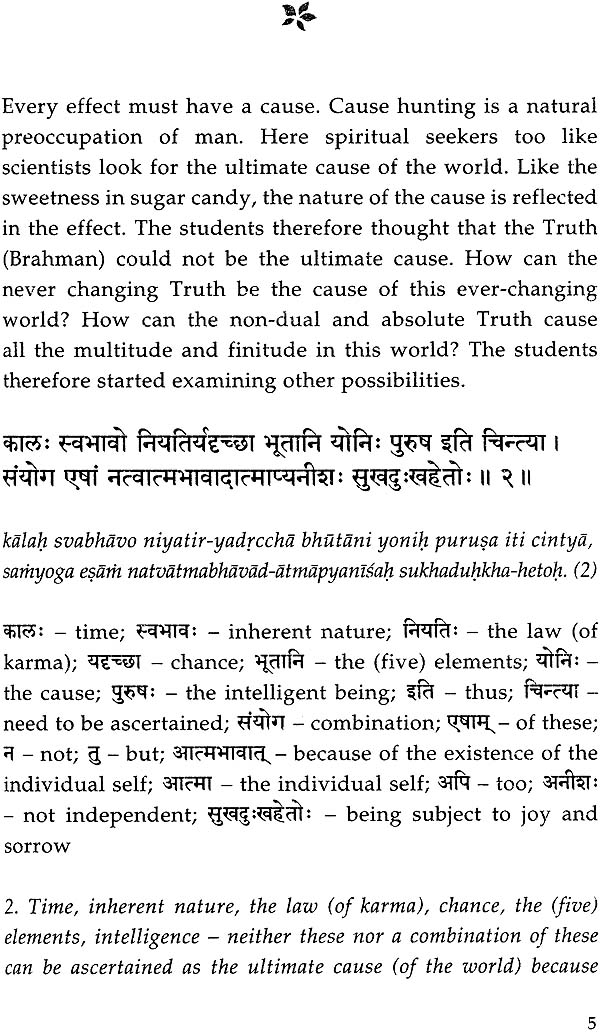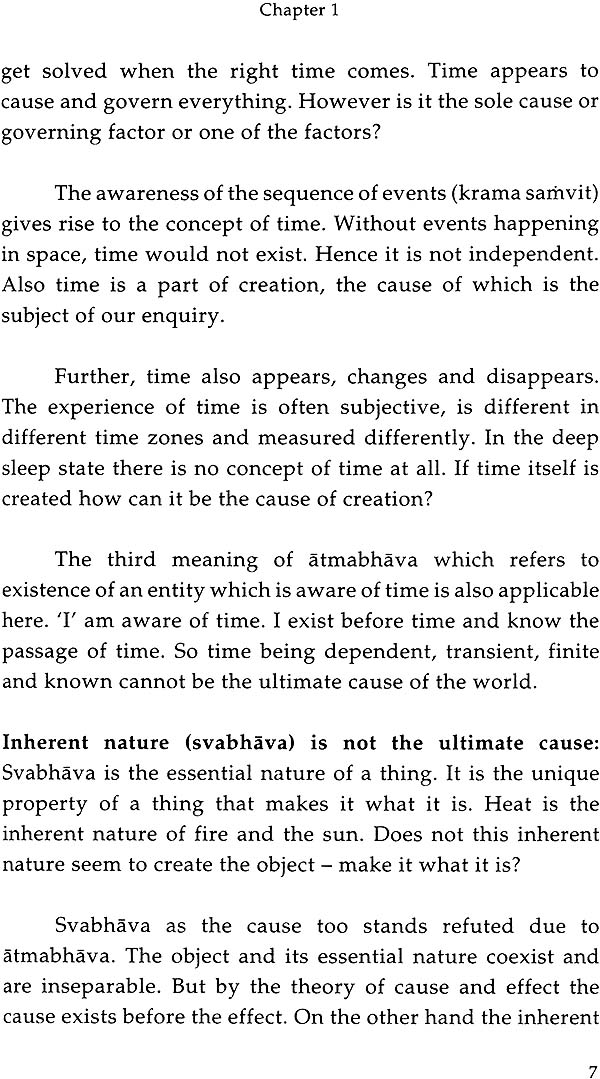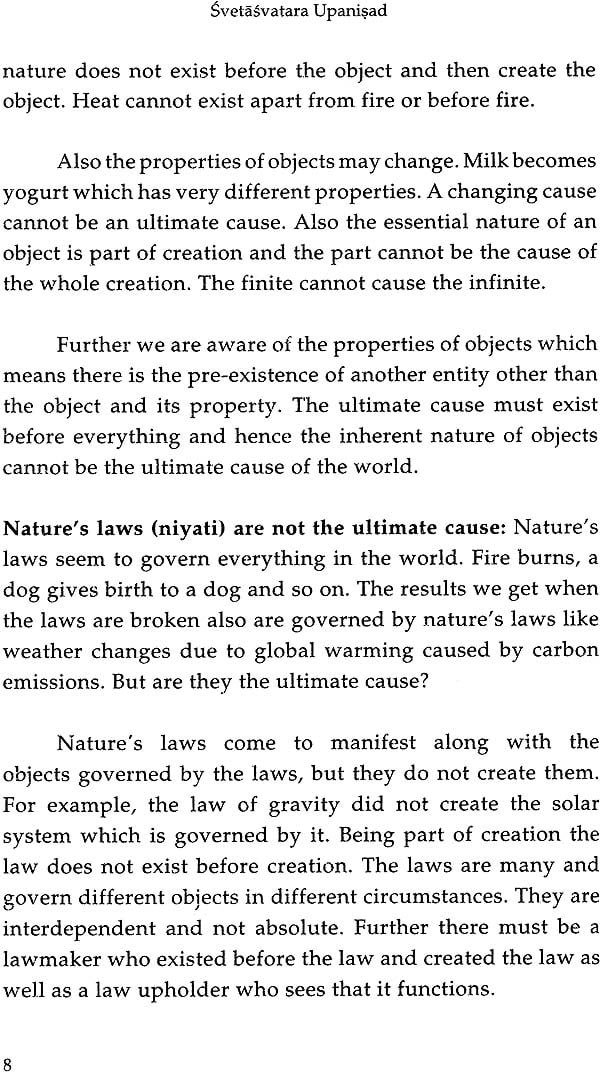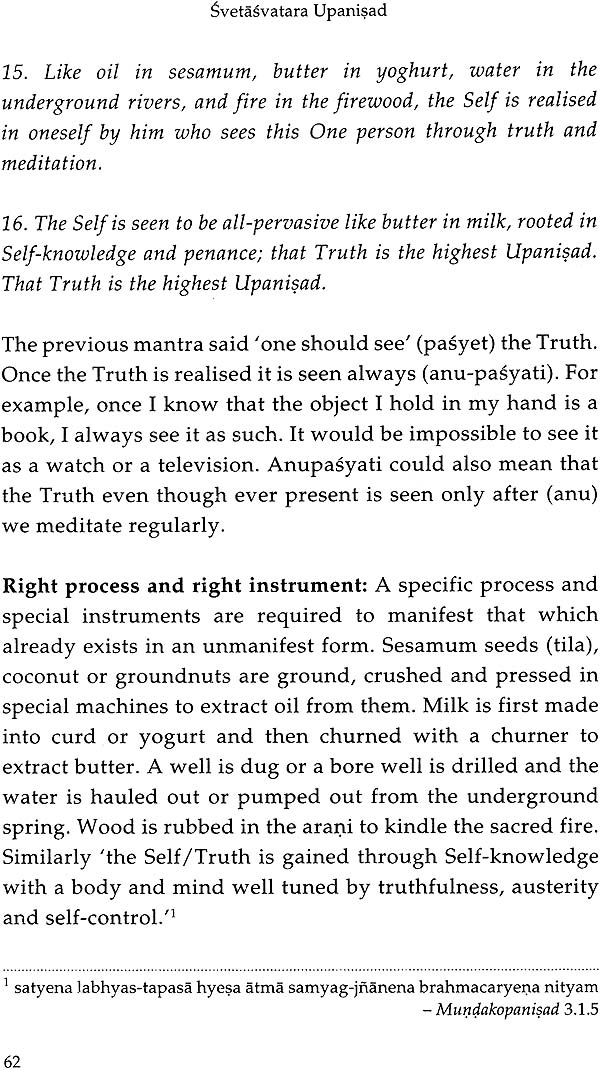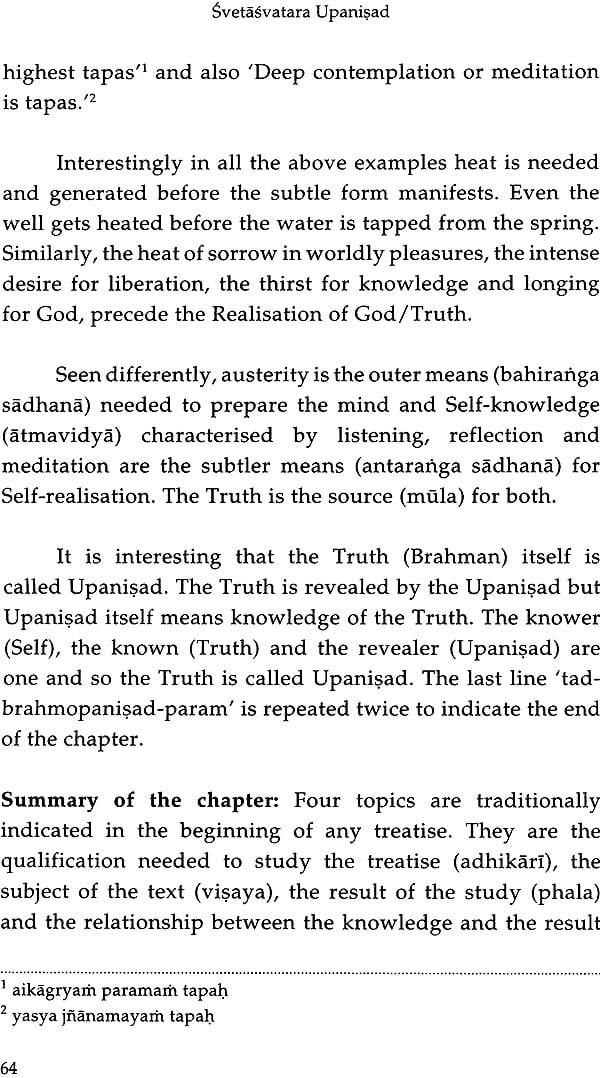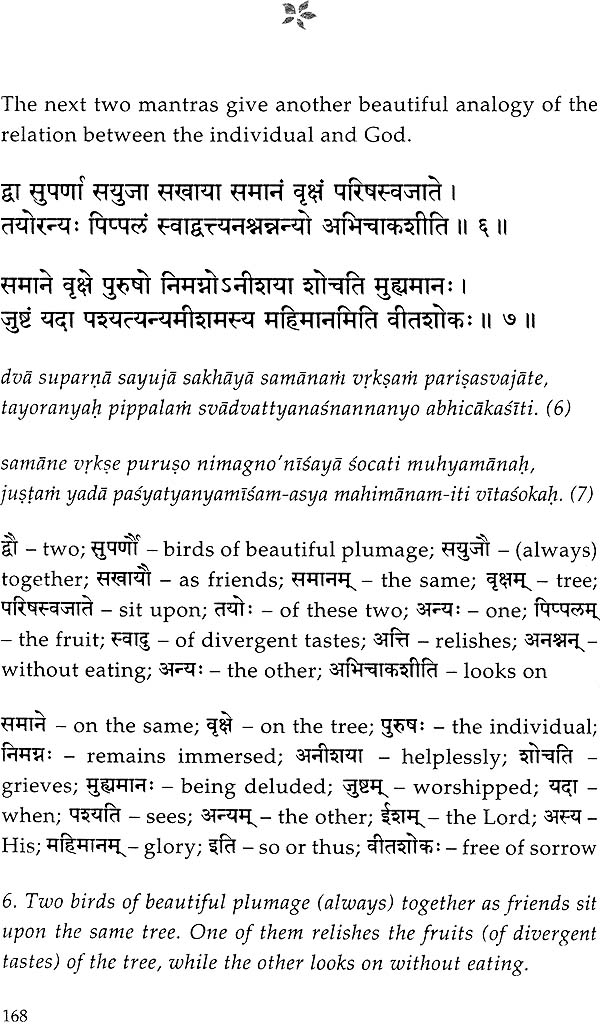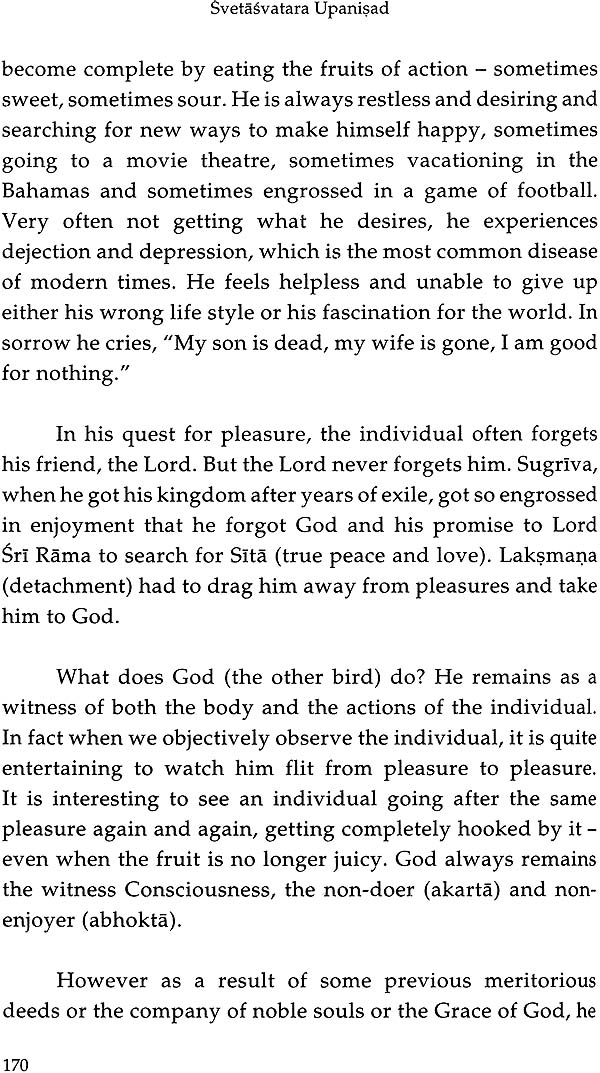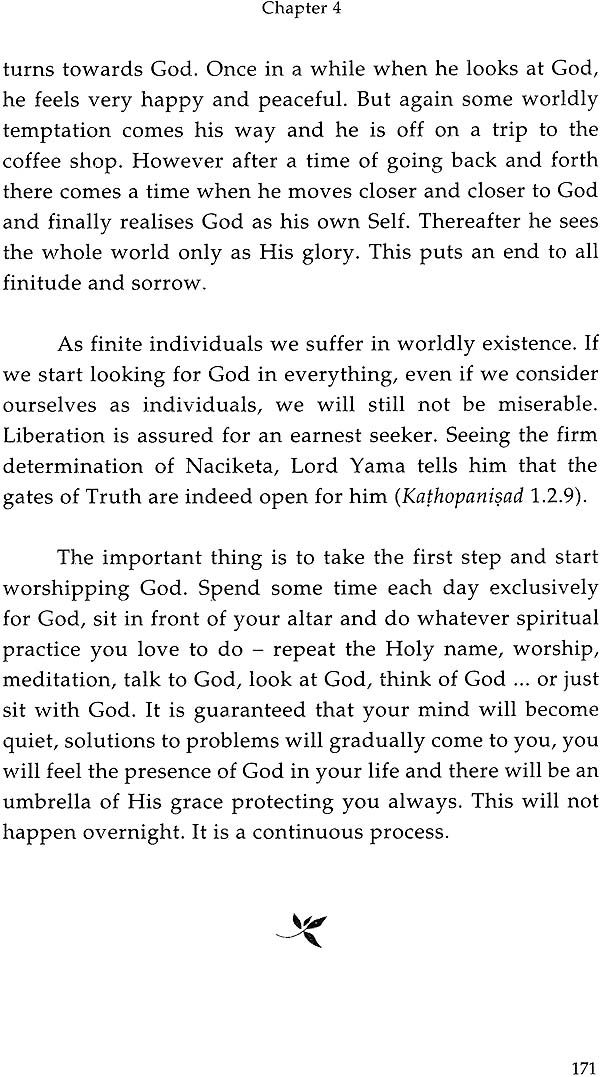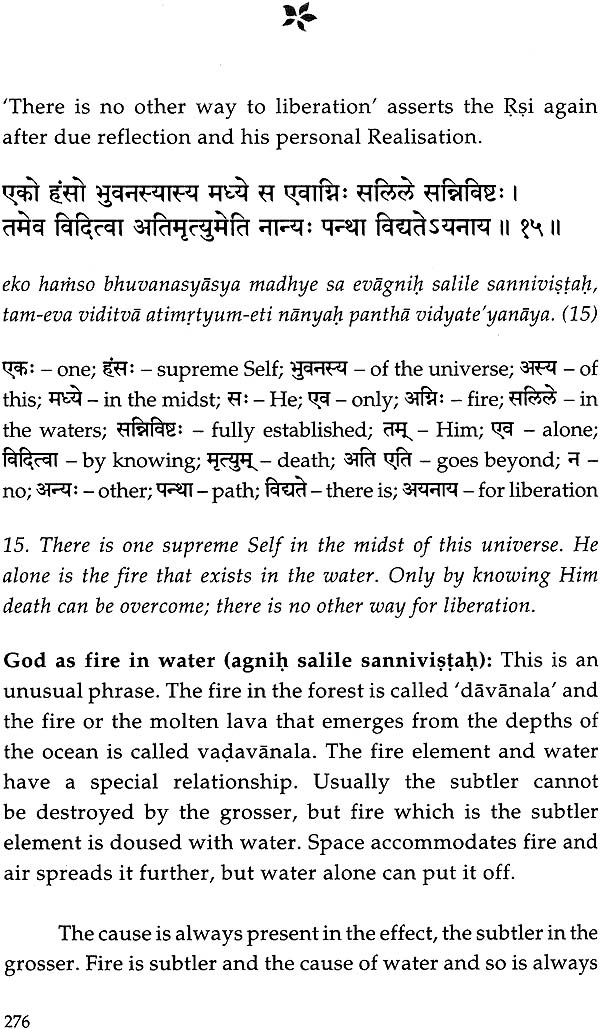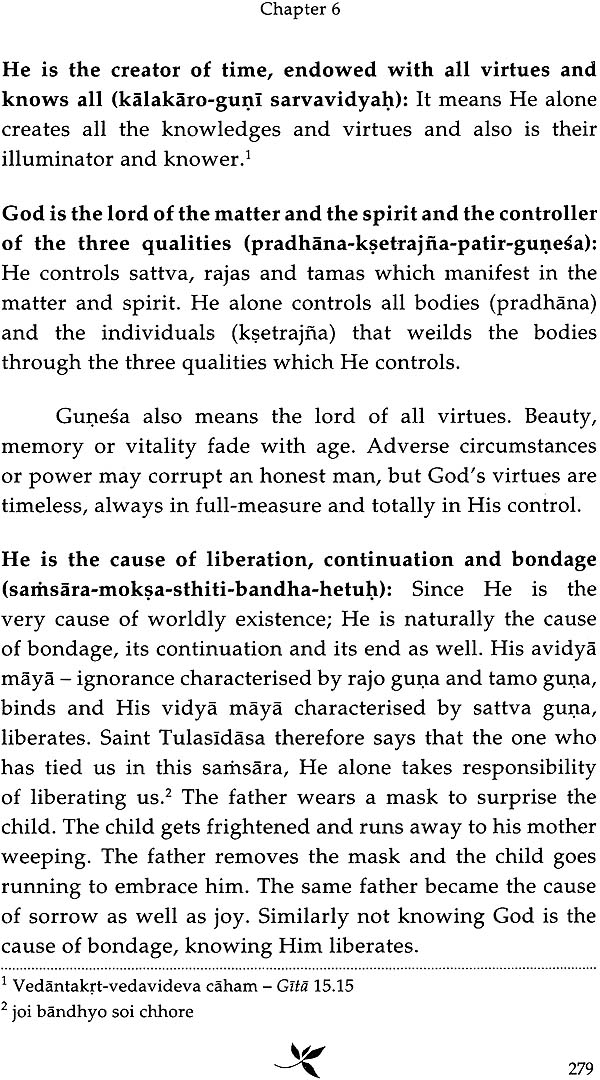
Svetasvatara Upanisad (Sanskrit Text, Roman Transliteration, Word-to-Word Meaning, English Translation and Detailed Explanation)
Book Specification
| Item Code: | NAD722 |
| Author: | Swami Tejomayananda |
| Publisher: | CENTRAL CHINMAYA MISSION TRUST |
| Language: | (Sanskrit Text, Roman Transliteration, Word-to-Word Meaning, English Translation and Detailed Explan |
| Edition: | 2013 |
| ISBN: | 9788175975286 |
| Pages: | 309 |
| Cover: | Paperback |
| Other Details | 8.5 inch X 5.5 inch |
| Weight | 360 gm |
Book Description
Svetasvatara Upanisad, an important text on Vedanta starts with a discussion on the original cause of creation. Whilst exploring concepts of time, space, nature, power, deities, heavens, karma and elements it gives us a divine vision of viewing this multidimensional and vast world. Through beautiful mantras we understand the role of meditation, devotion, prayer, surrender, the Guru and scriptures in our life. It mainly reveals the true nature of God/Truth and establishes our essential oneness with Him. With the thought-provoking reflections of Swami Tejomayananda, every reader cannot help but come to the conclusion, 'I am infinite and immortal in my true nature.'
Pujya Guruji Swami Tejomayananda is an outstanding teacher of Vedanta, with a profound depth beneath his simplicity and humility. He has a simple conviction - to fortify, strengthen and actualise the vision of his Guru, Pujya Swami Chinmayananda. Swamiji has written commentaries on many Vedantic texts and authored many original compositions on Vedanta and Bhakti (Devotion).
He is the current head of the Chinmaya Mission- a global spiritual organisation with more than 250 centers worldwide.
Veda means knowledge - knowledge of the truths that governs the universe. As texts, they were compiled by Bhagavan Veda Vyasa into four volumes, namely B.g Veda, Yajur Veda, Sarna Veda and Atharva Veda. They are the very foundation of Hindu philosophy and are considered the highest authority and the supreme means of knowledge in determining the nature of Dharma and the nature of the absolute Reality - Brahman.
Each Veda has three sections - karrna-kanda, up as ana- kanda and jnana-kanda. Karrna-kanda is the ritualistic portion whose practice is meant to purify the mind of its impurities (mala) like attachments, dislikes, anger and so forth. It also contains rituals to fulfill our special and other worldly desires like knowledge of rituals for one desiring a son (putra kamesti yajna), even though incapable of bearing one or means to attain a specific heaven (svarga karnesti yajna).
Upasana-kanda contains mantras, means of worship and meditations which are primarily meant for removing the distractions of the mind (viksepa) and rendering it single pointed. They also promise attainment of extraordinary powers (siddhis) and various heavenly bodies and heavenly worlds (lokas).
Jnana-kanda contains Self-knowledge which removes the ignorance (ajnana-avarana) of our own true nature/Self/ Truth. It is this ignorance of our infinite nature (avidya)that gives rise to all our desires (kama) to become full and complete. They in turn engage us in various actions (karma) which result in the experience of joy and sorrow. We often feel that joy comes and goes, but sorrow seems to remain all the time. Total fulfilment and peace can therefore arise only by the removal of the basic ignorance behind all desires, actions, joys and sorrows.
Jana-kanda is also called Upanisad. The word Upanisad therefore means Self-knowledge (upanisad sabdena brahma-vidya ucyate). An object can be known by different people by different names, but its knowledge remains the same. For example, a book is known as a book, even if it is called 'pustakam', 'copadi and 'livre' in Sanskrit, Gujarati and in French respectively. Again, knowledge takes place through a specific means of knowledge (pramana). For example, the color of an object is perceived only by the eyes and not the ears. Self-knowledge is the means that removes ignorance of the Self and therefore Upanisad is the means for knowledge of the Self/Truth. Self-knowledge is one and therefore Upanisad is also one. However the knowledge of the Upanisads was revealed as various texts, hence these texts are also called Upanisads.
Someone asked a saint, "How many Upanisads will I need to study to know the Truth?" He asked back, "How many mirrors do you need to see your face?" One is enough. You may look into many mirrors, but what you need is just one. Similarly the study of just one Upanisad is enough to know the Truth/Self. However we do love to look at ourselves in every reflecting surface and admire ourselves. In the same way we can enjoy looking at the Self through different Upanisads as each has its own special beauty and reveals some aspect of the Truth elaborately. So it is good to study different Upanisads.
As texts, the Upanisads are found mostly in th7 end part of the Vedas and therefore its knowledge is called Vedanta (veda + anta). Some consider that there are 108 Upanisads. Amongst them, ten are well-known as major Upanisads as Adi Sankaracarya has written commentaries on them. If we study them well, the others can be understood easily. They are Isavasya Upanisad, Kenopanisad, Kathopanisad, Prasnopanisad, Mundakopanisad, Mandukya Upanisad, Aitareya Upanisad, Taittiriya Upaniead, Chandogua Upanisad and Brhadaranyaka Upanisad. They are referred to as Dasopanisads - the ten Upanisads.
Some say that Adi Sankaracarya has also written a commentary on Suetasoatara Upanisad and therefore consider it also as a major Upanisad. However the language and the style of the commentary available do not seem to be that of Adi Sankaracarya. Perhaps a later Sankaracarya' of a particular pitha might have written the commentary. Also, Sri Ananda Giri has written explanatory notes (tika) on all the commentaries of Adi Sankaracarya like the Upanisads, Brahma Suiras and Bhagavad cua. He has not written notes on Svetasvatara Upanisad, which is another indication that the commentary available on the Soetasuatara Upanisad is not written by Adi Sankaracarya. This however does not detract from its merit and its study surely helps us in understanding the Upanisad better.
Svetasvatara Upanisad is part of the Yajur Veda. It has six chapters and 112 mantras. All Upanisads are dialogues between the teacher and his disciples. The last chapter of this Upanisad mentions that sage Svetasvatara is the teacher in this Upanisad and he taught some highly qualified disciples. Nothing more is known about the background of this Upanisad. Svetasvatara does not appear to be the name of the sage, but a title given to him. Sveta means white or pure and asva is a horse which symbolises our senses'. Svetasvatara means one endowed with pure senses.
We may wonder how the senses can be pure or impure. The mind that entertains likes and dislikes for sense objects is called impure. For example, one may love chocolates and dislike greens. Like unbroken and untamed horses, the mind driven by likes and dislikes is uncontrolled, whereas like the well disciplined horses, the controlled senses and mind make life's journey comfortable and joyous. The point being made is that Sage Svetasvatara was a wise man who had full control over his senses and mind. The specialty of this Upanisad is that many of its mantras are found in the Samhita portion of the Vedas where their meaning is related to the performance of rituals. It also contains many mantras of other Upanisads. Also, Brahma Sutras composed by Bhagavan Veda Vyasa to reveal the true meaning of the Vedas, comments on many of the mantras of this Upanisad. All in all, it is an elevating and beautiful Upanisad.
